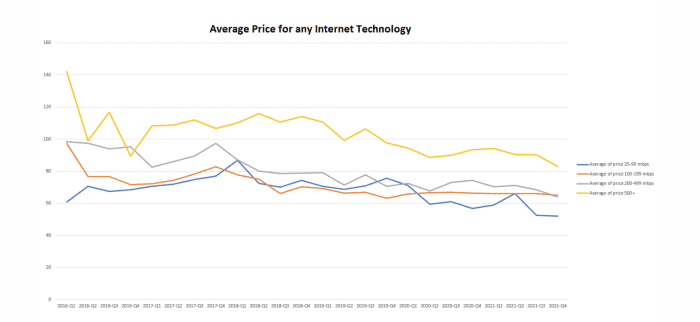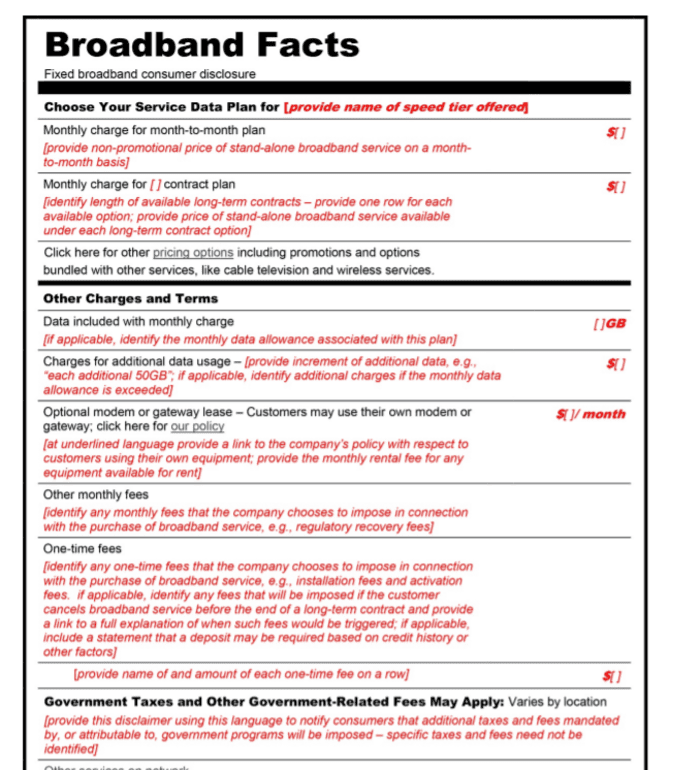High-speed internet is getting cheaper in America, according to a new study
Costs of high-speed internet have been dramatically declining since 2016, even before the Biden administration secured a $65 billion pot of federal funds to provide all households with access to fast and affordable connections, according to a new report.
Prices tumbled by almost $60 a month on average, or 42%, for customers hooked up with 500-mbps internet speeds, an ultra-fast category for households, in the past five years, according to a new study from BroadbandNow.
For slower categories, prices dropped from 14% to 35% on average, with the smallest declines found in the “entry level” category at 25- to 99-mbps speeds (see: blue line in chart), where monthly prices were cut by $8.80 on average.

Prices fall the most for “luxury” connections.
BroadbandNow
While faster 500-mbps internet speeds still may be a “luxury” item for many households, it is cable and fiber technology dominating at speeds of at least 200 mbps, or what many high-speed households enjoy, according to Tyler Cooper, editor-in-chief at BroadbandNow, which tracks government data on the nation’s digital infrastructure for a consumer audience.
“Fiber is a growth sector, so you are seeing huge investments from AT&T T,
For the study, Cooper’s team looked at pricing data for 50 national and regional providers of broadband service, across all major download speeds and technologies, including cable, fiber, DSL and fixed wireless. They tracked prices from the first quarter of 2016 through the fourth quarter of 2021.
Notably, the study found internet costs declining in most speed categories (see above chart) even as the pandemic forced millions of American families to become more heavily dependent on internet access for work, school, doctors’ appointments and more.
Prices also dipped late in 2021, as the Biden administration secured $65 billion in broadband funding from Congress through a $1 trillion infrastructure spending package.
What comes next
Plans to support internet expansion under the far-reaching infrastructure law have been ramping up, both in terms of teeing up state grants to bolster digital connections, but also to tackle affordability.
Read: How the infrastructure bill’s $65 billion in broadband spending will be doled out
The Federal Communications Commission’s Affordable Connectivity Program has been encouraging more low-income households to sign up for monthly subsidies of up to $30, and up to $75 a month for families in tribal communities.
The latest reading of its national tracker showed nearly 10 million households already enrolled in the program as of February 7.
The FCC also has proposed simple “consumer labels” for internet service providers that disclose fees and costs, akin to the Food and Drug Administration’s nutrition labels. Here’s a proposed version:

A proposed label for internet services.
FCC
For its part, the National Telecommunications and Information Administration (NTIA), the Commerce Department’s telecom division, told MarketWatch on Tuesday it has until May 16 to kick off its three-part $42.5 billion grant process for states to expand local internet under the infrastructure law, and thereafter will provide up to $5 million per state for planning purposes.
In response to the NTIA’s request for public comment, the Pew Charitable Trusts’ Kathryn de Wit, a program director of its Broadband Access Initiative, last week urged the agency to “give priority to the deployment of fiber,” in a written response on what broadband infrastructure will be needed in America over the next 20 years.
Cooper at BroadbandNow said he also hopes states opt to fund not only technology that will hold up over time, but that states will promote competition among broadband providers so that consumers can get the best prices — a dynamic that’s been missing in many markets for decades.




